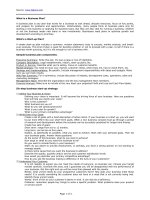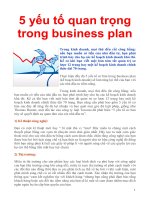Business Plan Templates Projections_5 ppt
Bạn đang xem bản rút gọn của tài liệu. Xem và tải ngay bản đầy đủ của tài liệu tại đây (105.9 KB, 12 trang )
Payments
Repayments
Investments
S
a
l
e
s
P
u
r
c
h
a
s
e
s
Payment
received
P
r
o
c
e
s
s
P
r
o
c
e
s
s
CASH
Capital
Dept
Asset sales
Debtors
W.I.P.
Stock
Raw
Materials
PLANNING PROCESS
7: FINANCIAL MODELLING
Liquidity and Cashflow Cycle
57
PLANNING PROCESS
7: FINANCIAL MODELLING
In addition, you need to:
● Demonstrate tight control over costs vis-a-vis income
● Demonstrate that you can service debt
● Provide an adequate return on invested capital
● Retain earnings for growth
You must, therefore, produce financial models to support these, including:
● Cashflow forecasts
● Projected profit and loss
● Expected balance sheets
● Funds flow statement
The latter three statements are probably inappropriate for internal
departments. Many organisations produce cashflows on a regular basis
(weekly) for management purposes.
58
PLANNING PROCESS
7: FINANCIAL MODELLING
CASHFLOW FORECASTS
● These are estimates of the likely expenditure and receipts in cash terms
over the next 12 months.
● Cashflow is vital to a business and anyone looking either to lend, invest or
extend credit to you will wish to see that the business can generate sufficient
cash to cover its outgoings.
● An accurate cashflow will enable you to predict your financing needs, allowing
you to establish facilities in advance when lenders are more sympathetic, rather
than afterwards, when they will be less so.
● Producing a cashflow forecast allows you to demonstrate that you have
thought through the flows of cash (not funds or profit). Interested parties
can then challenge your assumptions; your answers to these
challenges will give them confidence that the assumptions,
and therefore the forecast, are likely to prove robust.
59
PLANNING PROCESS
7: FINANCIAL MODELLING
CASHFLOW FORECAST : EXAMPLE
This enables financing needs (months x and y) to be predicted and catered for in advance.
60
Opening balance
Receipts
Debtors
Assets sales
Capital injection
Interest received
Dividends received
Expenditure
Salaries
Rent
Rates
Assets purchase
Creditors
Ta x
Drawings/dividends
Closing balance
1
xx
xx
xx
xx
xx
xx
xx
xx
xx
xx
xx
xx
xx
xx
xx
45 72 96 (123) 50 83 87 (123) 67 96 123 48
2
45
xx
xx
xx
xx
xx
xx
xx
xx
xx
xx
xx
xx
xx
xx
3
72
xx
xx
xx
xx
xx
xx
xx
xx
xx
xx
xx
xx
xx
xx
4
96
xx
xx
xx
xx
xx
xx
xx
xx
xx
xx
xx
xx
xx
xx
5
(123)
xx
xx
xx
xx
xx
xx
xx
xx
xx
xx
xx
xx
xx
xx
6
50
xx
xx
xx
xx
xx
xx
xx
xx
xx
xx
xx
xx
xx
xx
7
83
xx
xx
xx
xx
xx
xx
xx
xx
xx
xx
xx
xx
xx
xx
8
87
xx
xx
xx
xx
xx
xx
xx
xx
xx
xx
xx
xx
xx
xx
9
(123)
xx
xx
xx
xx
xx
xx
xx
xx
xx
xx
xx
xx
xx
xx
10
67
xx
xx
xx
xx
xx
xx
xx
xx
xx
xx
xx
xx
xx
xx
11
96
xx
xx
xx
xx
xx
xx
xx
xx
xx
xx
xx
xx
xx
xx
12
123
xx
xx
xx
xx
xx
xx
xx
xx
xx
xx
xx
xx
xx
xx
MONTH
PLANNING PROCESS
7: FINANCIAL MODELLING
PROFIT & LOSS
This is a statement of the historical performance of a business or unit in terms of:
● Its annual revenue and the key components
● The costs associated with that revenue and the major categories
● The resulting profit (gross and net)
● How the profit was apportioned (paid out as dividends, placed into reserves
for future growth, etc)
It serves as a useful financial statement for assessment of past performance as well as
extrapolated likely future trends.
Producing a forecast profit and loss as part of your plan will demonstrate the impact of
the plan in financial performance terms.
Internal/support departments will not usually have them.
61
PLANNING PROCESS
7: FINANCIAL MODELLING
PROFIT & LOSS: EXAMPLE
62
INCOME STATEMENT
TURNOVER
Less
Cost of sales
Distribution costs
Administration costs
Plus
Other operating income
Adjustments
TRADING PROFIT
Associated co’s profits
PROFIT BEFORE INTEREST & TAX
Net interest payable(+/-)
PROFIT BEFORE TAX
Tax payable
PROFIT AFTER TAX
Minorities
Extraordinaries
NET PROFIT
Dividends
PROFIT RETAINED
£m
107.0
32.0
13.0
27.0
11.0
(3.0)
43.0
2.0
45.0
(13.0)
32.0
(17.0)
15.0
–
(5.0)
10.0
4.0
6.0
PLANNING PROCESS
7: FINANCIAL MODELLING
BALANCE SHEET
The balance sheet is a ‘snapshot’ of an organisation’s position as at a given date (usually
the end of a year, either fiscal or actual).
It shows:
● The assets of an organisation - what it owns
● The liabilities of an organisation - what it owes
● The difference is what an organisation is worth - often called equity,
shareholders’ net worth, etc
Although only a picture of one day, it does nevertheless give valuable information as to
component parts of an organisation.
A good plan will often include a forecast balance sheet to demonstrate the
impacts on asset and liabilities. Many organisations produce this on a
regular basis (weekly) for management purposes.
63
PLANNING PROCESS
7: FINANCIAL MODELLING
BALANCE SHEET : EXAMPLE
64
Current assets (cash, investments, debtors, stock, prepayments)
Less
Current liabilities (tax, creditors, S/T debt, dividends)
Net working capital
Plus
Fixed assets (plant, machinery, land and buildings, IT, etc)
Less
Creditors (loans, long-term creditors, deferred tax)
Net assets
financed by
Shareholders’ (capital, retained profit, reserves)
net worth
£ m
50
(25)
15
100
(70)
45
45
PLANNING PROCESS
7: FINANCIAL MODELLING
SOURCES & USES OF FUNDS
This statement shows how an organisation funded itself through the year. In particular it
shows:
● Where the money came from
● Where it went
● The duration of the funds in
● The maturity of funds out (to allow mismatch analysis)
It is self-evident that sources and uses should by and large reflect the same timescale. It
would be very foolish to borrow short-term (less than three months or even overnight) to
fund a long-term (eg: five year) project. Interest rates would probably move against you,
maturity of outflows would almost certainly occur at unfavourable times, and you might
be unable to fund the project at any given time if there was a credit squeeze.
Demonstrating that this aspect has been considered goes a long way to
instilling confidence in you and your plan.
65
66
PLANNING PROCESS
7: FINANCIAL MODELLING
SOURCES & USES STATEMENT
Sources
● Pre-tax profit
● Depreciation
● Sales of assets
● Decrease in stocks
● Decrease in debtors
● Shares issued
● Increased loans
● Increased creditors
Applications/uses
● Dividends paid/drawings
● Tax payments
● Loan repayments
● Decrease in creditors
● Increase in stocks
● Increase in debtors
● Purchase of assets
PLANNING PROCESS
7: FINANCIAL MODELLING
SOURCES & USES
Key points - there are only four sources of funds:
● Cashflow from operations
● Asset sales
Funds will not come from anywhere else, so any funding must be explained in these
terms. Anyone looking at the plan will give especial attention to funding, as it is a lack of
this that causes problems.
This statement provides the link between the opening balance sheet, the profit and loss
for the period and the closing balance sheet.
Sources of funds are increases in liabilities (increase in borrowing/capital) or
decreases in assets (release of funds, use of cash), Applications of funds
are decreases in liabilities (repayments/payments) or increases in assets
(purchases or extra cash).
67
● Capital injection
● Debt
NOTES
68









